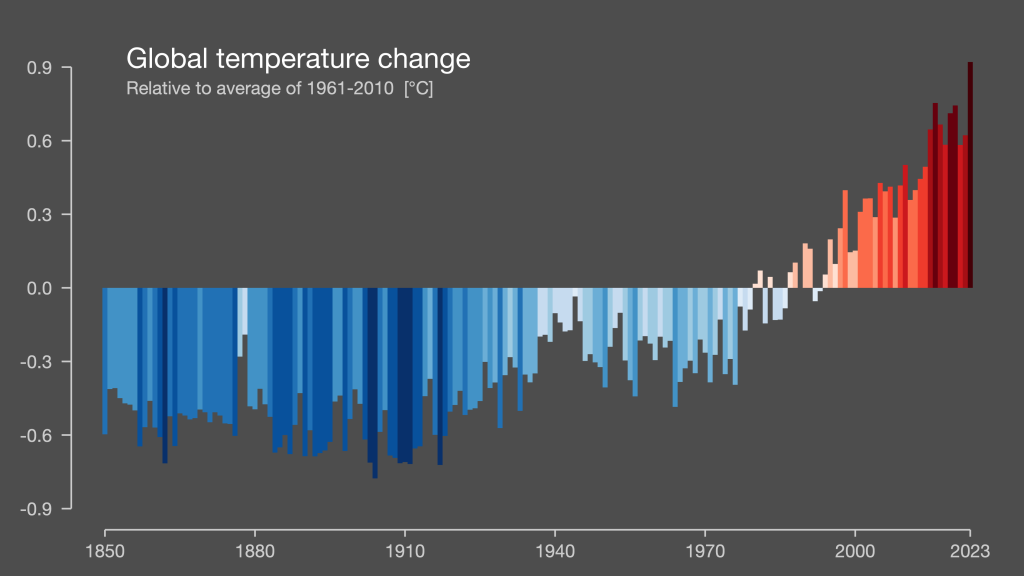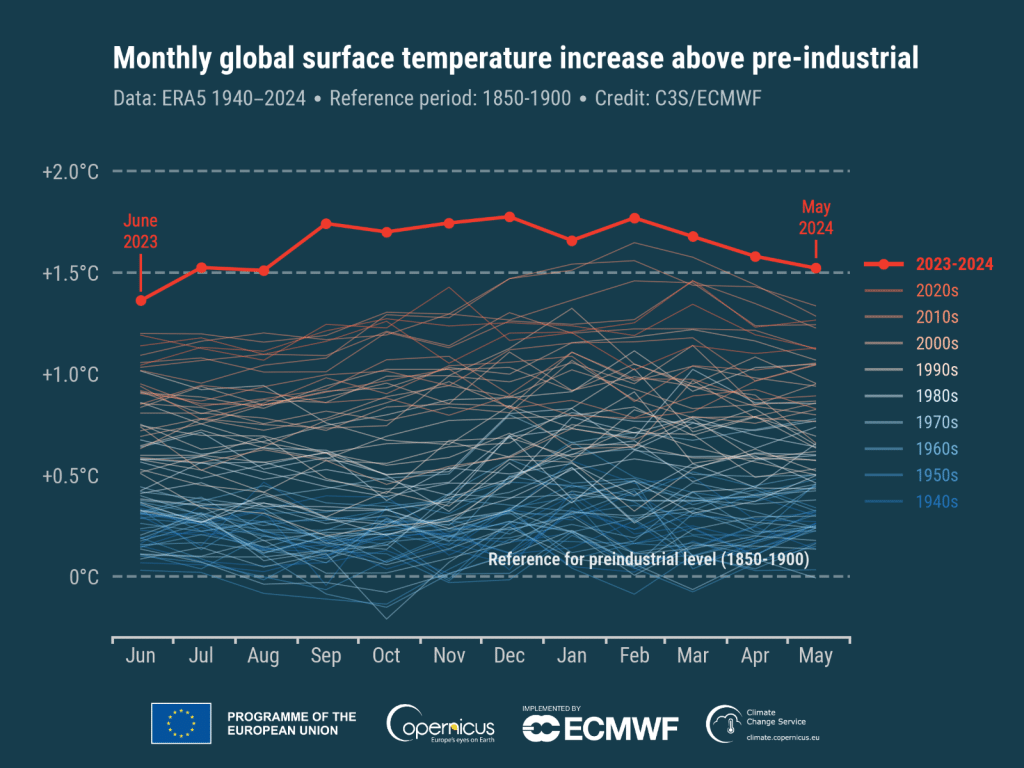
June 21, 2024 marks the seventh annual Show Your Stripes Day – an event dedicated to growing global awareness about human-caused climate change and turning the climate conversation into action by using and sharing the famous “warming stripes” visualization using the hashtag #ShowYourStripes. But how did these stripes originate and what is the real meaning behind them?
Created by climate scientist Ed Hawkins, the “warming stripes” are visual representations of annual or monthly temperature anomalies for a specific location or region over the past 100+ years. The visualization uses a color scale to represent temperature deviations from a baseline average, typically spanning several decades.
In the warming stripes visualization, each stripe or bar represents a single year or month, and the color of the stripe represents the temperature anomaly for that specific time period. Blue shades indicate cooler temperatures or negative anomalies, while red shades represent warmer temperatures or positive anomalies.
Impressed by people’s reaction to the stripes, Hawkins, who is Professor of Climate Science at the University of Reading and principal research scientist at the UK’s National Centre for Atmospheric Science (NCAS), decided to simplify the visualization, arranging the stripes in a horizontal sequence and simplifying the color pallet to create a visually striking pattern that allows for easy interpretation of temperature trends over time.

Since then, warming stripes have gained popularity as a way to communicate complex climate data in a visually appealing and accessible manner, providing a concise and intuitive representation of temperature changes.
________________________________________________________________________
READ ALSO : Ozne chart shows the best and worst face masks for coronavirus protection — and…
________________________________________________________________________
On June 21, 2024, Hawkins launched the seventh annual campaign ‘Show Your Stripes‘ – a day to encourage people around the world to replicate the powerful image and share it on social media using the hashtag #ShareYourStripes.



________________________________________________________________________
Read Also : 140 year old mother tortoise wearing her 5 day old son as a hat,
________________________________________________________________________




‘Off the Scale’
The past nine years have been the hottest on record, with 2023 topping the ranking with global average temperatures standing at 1.48C warmer than the 1850-1900 pre-industrial level.
In January 2024, Hawkins said global temperatures were so hot in 2023 that the latest warming stripes image needed updating, requiring a darker red color.
“The colours used in the climate stripes are based on a scale designed to show which years are warmer and cooler than the average. 2023 was off the end of the scale,” the scientist said.
________________________________________________________________________
Read Also : Delicate Flowers of Carved Wood by Yoshihiro Suda Spring Out from Cracks
________________________________________________________________________
“This was always going to happen at some point, given the continued increase in global greenhouse gases, and is in line with what scientists have been predicting for decades. But the margin of record breaking in 2023 has still been a surprise. The climate stripes are all about starting conversations about climate change, and 2024 has to be the year we turn conversations into faster action.”
Last year’s record-breaking temperatures can be partly attributed to the return of El Niño, a weather pattern associated with the unusual warming of surface waters in the eastern equatorial Pacific Ocean. However, despite scientists confirming the gradual weakening of the pattern in recent weeks, the trend has continued well into the new year, with this past winter as a whole setting new high-temperature marks and May 2024 marking the 12th consecutive hottest month on record in terms of air surface temperature and the 14th month in a row of record-breaking sea surface temperature.
May was also 1.52C above the 1850–1900 pre-industrial average, marking the 11th consecutive month that temperatures breached the 1.5C global warming threshold set in the Paris Agreement. While this does not signal a permanent breach of the critical limit, which scientists say is measured over decades, it sends a clear warning to humanity that we are approaching the point of no return much faster than expected.
Speaking with Earth.Org in April, leading Earth scientist Johan Rockström said climate scientists are struggling to understand or explain these climate trends.
“We had seen El Niño conditions before, so we expected higher surface temperatures [last year] because the Pacific ocean releases heat. But what happened in 2023 was nothing close to 2016, the second-warmest year on record. It was beyond anything we expected and no climate models can reproduce what happened. And then 2024 starts, and it gets even warmer,” said Rockström. “We cannot explain these [trends] yet and it makes scientists that work on Earth resilience like myself very nervous.”

The burning of coal, natural gas, and oil for electricity and heat is the single-largest source of global greenhouse gas (GHG) emissions, the primary drivers of global warming by trapping heat in the atmosphere and raising Earth’s surface temperature. Global fossil fuel consumption has more than doubled in the last 50 years, as countries around the world aim to improve their standards of living and economic output. In 2023, all three of the most potent GHGs – carbon dioxide (CO2), methane, and nitrous oxide – reached record highs.
CO2, a by-product of burning fossil fuels, biomass, land-use changes, and industrial processes such as cement production, is the principal anthropogenic greenhouse gas in the atmosphere, responsible for about three-quarters of planet-warming emissions. Global CO2 emissions from fossil fuels have increased by more than 60% since 1990.
So far, the world has warmed by 1.2C compared to pre-industrial times, though data by the Intergovernmental Panel on Climate Change (IPCC) suggests that 20-40% of the global human population live in regions that, by the decade 2006–2015, had already experienced warming of more than 1.5C in at least one season. According to the UN body, every 0.5C (0.9F) of global warming will cause discernible increases in the frequency and severity of heat extremes, heavy rainfall events, and regional droughts.
Featured image: Professor Ed Hawkins (University of Reading)
How can I contribute to a more sustainable planet?
- 🗳️ Vote for Climate Action: Exercise your democratic rights by supporting candidates and policies that prioritize climate change mitigation and environmental protection. Stay informed with Earth.Org’s election coverage.
- 👣 Reduce Your Carbon Footprint: Make conscious choices to reduce your carbon footprint. Opt for renewable energy sources, conserve energy at home, use public transportation or carpool, and embrace sustainable practices like recycling and composting.
- 💰 Support Environmental Organizations: Join forces with organizations like Earth.Org and its NGO partners, dedicated to educating the public on environmental issues and solutions, supporting conservation efforts, holding those responsible accountable, and advocating for effective environmental solutions. Your support can amplify their efforts and drive positive change.
- 🌱 Embrace Sustainable Habits: Make sustainable choices in your everyday life. Reduce single-use plastics, choose eco-friendly products, prioritize a plant-based diet and reduce meat consumption, and opt for sustainable fashion and transportation. Small changes can have a big impact.
- 💬 Be Vocal, Engage and Educate Others: Spread awareness about the climate crisis and the importance of environmental stewardship. Engage in conversations, share information, and inspire others to take action. Together, we can create a global movement for a sustainable future.
- 🪧 Stand with Climate Activists: Show your support for activists on the frontlines of climate action. Attend peaceful protests, rallies, and marches, or join online campaigns to raise awareness and demand policy changes. By amplifying their voices, you contribute to building a stronger movement for climate justice and a sustainable future.
NOTE – This article was originally published in earth and can be viewed here







